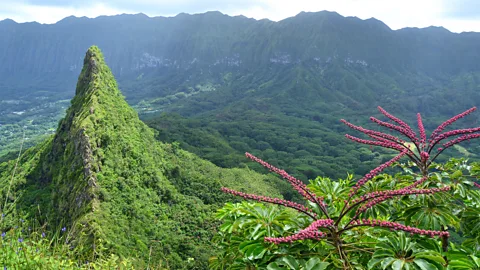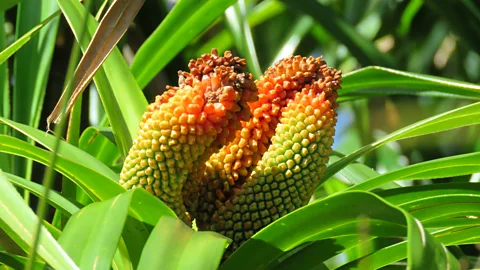This Hawaiian island's 'freakosystems' are a warning from the future
 Sean MacDonald
Sean MacDonaldEcosystems which have never been seen before are being accidentally created by humans. They offer a stark look into the nature of tomorrow.
Venture deep into the forests on O'ahu, Hawaii's third largest island, and you'll find yourself threading through a dense understory of richly scented pepper, cinnamon and guava trees.
"It's beautiful," says Corey Tarwater, an ecologist at the University of Wyoming in the US who began researching O'ahu's ecosystems in 2014. Sounds like the "cheww-chewww" song of the pale green warbling white-eye and the chattering, almost electrical call of the red-billed leiothrix surround you. "There's really neat lizards around," adds Tarwater. "There's these highly structured forests with these amazing tropical plant species."
For hikers setting out on O'ahu's mountain trails, these are thrilling wildernesses within easy reach of Hawaii's capital, Honolulu, says Tarwater. Yet nothing is quite as it might seem, she adds. "You wouldn't know unless you study them, but if you walk around any forest around Honolulu, there's not going to be one single native plant species there."
O'ahu's lowland forests are now almost entirely devoid of the plants and animals that grew here for millions of years before the arrival of humans. Settlers brought extinctions by cutting down trees to make farms and introducing voracious predators and disease-carrying animals. Today, these tropical forests are a tapestry of non-native species introduced from every corner of the planet: Brazilian peppertree, Indonesian cinnamon and roseleaf bramble from the Himalayas and Australia. Most of the animals, including all the birds that Tarwater mentioned earlier, are also alien.
O'ahu's mountainous terrain – a filming location that has evoked heroic, untrammelled wildernesses in the Jurassic Park and King Kong films – is shaped "at every level" by human action, says Jef Vizentin-Bugoni, a Brazilian ecologist at Universidade Federal de Pelota who researched the island's birds with Tarwater. He recalls having his expectations upturned when he arrived on the island in 2017, eager to see Hawaii's famous honeycreepers, a set of brightly coloured native bird species that exist nowhere else in the world. Instead, he was first confronted with an unfamiliar flurry of red and white feathers, which turned out to be a red-whiskered bulbul, a bird whose native range spans from India to Southern China.
"I followed it as it flitted between trees until it stopped to feed on a fruit I immediately recognised – guava, a plant native to Brazil," he says. "That moment captured the essence of what's happening in Hawaii: a South American plant being eaten by an Asian bird on a remote Pacific island."
Most of these exotic species arrived in the last century or two and were thrown together more or less at random – some are escaped pets, others relics from abandoned farms. Yet unlike urban environments where foxes and seagulls scratch together a living eating anything they can find, the forests of O'ahu show signs of structure and organisation.
 Jef Vizentin-Bugoni
Jef Vizentin-BugoniBirds that have only lived together for the last century have assumed specialist roles, such as distributing the seeds of native plants, that were once performed by now extinct birds. In a 2019 study, Tarwater and Vizentin-Bugoni analysed the eating patterns of birds and seed dispersal on the island to see how they compared to a structured and stable native ecosystem that had evolved together over millennia.
"If I compare what I'm seeing in O'ahu with what I see in the middle of the Amazon, will the interactions have the same organisation">More like this: • The ancient forest that s Venice • Hawaii's ancient land management system • The race to protect Pacific whales
To get the birds to spread native plants around, the team in O'ahu instead try to trick them. They use speakers to play the calls of "birds that we know are really good seed dispersers" to lure them to restoration sites where native plants remained, Tarwater says. "Once they're there, they're like: 'Oh, hey, look at that fruit!' and they'll eat it." (Read about how scientists coax back species with sound in other parts of the world too.)
Such strategies work with non-native birds to help conserve the tiny patches of remaining native plants – although many roles, such as the moa-nalos' dispersal of large seeds, are still not filled, as no non-native species are big enough.
It all makes unravelling what to do with these novel habitats difficult. "It's complex and depends on the goals of restoration," says Tarwater. A conservationist focusing on native plants may eradicate as many non-native competitors as possible, she says. "But if you're interested in conserving a native snail or some of these other species, that [non-native plant] might be the habitat that they currently rely upon."
While novel ecosystems remain controversial, on O'ahu, conservationists and land managers have become less black-and-white about native and non-native species, says Tarwater.
"We know that the challenges of the novel ecosystems are going to remain, and likely increase. We know that it's not as simple as them being good or bad."
--
For essential climate news and hopeful developments to your inbox, sign up to the window._taboola = window._taboola || []; _taboola.push({ mode: 'alternating-thumbnails-a', container: 'taboola-below-article', placement: 'Below Article', target_type: 'mix' });
